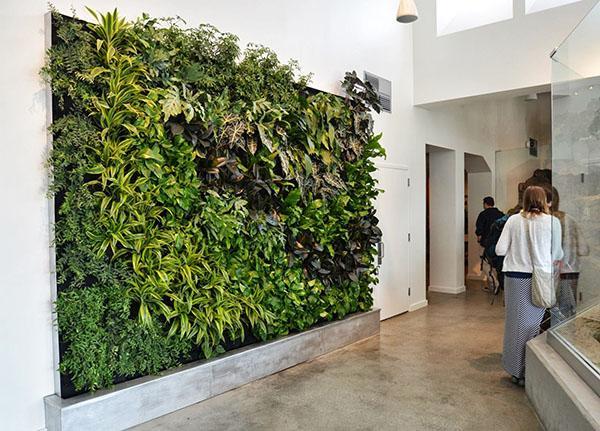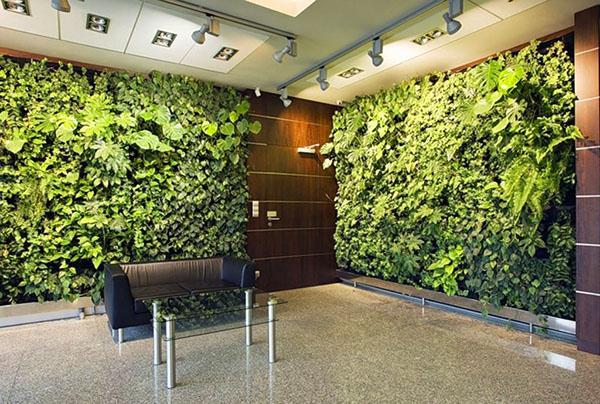Greetings from the distant past - original living wall
 One of the seven outstanding wonders of human creation are the Babylonian Hanging Gardens. The living wall, created by King Nebuchadnezzar in 605 BC, continues to arouse unprecedented admiration. In fact, at that time, this structure was not unusual. History shows that creating greenery in the spacious rooms of the palace was commonplace. The Babylonian king only improved the then well-known method of planting greenery.
One of the seven outstanding wonders of human creation are the Babylonian Hanging Gardens. The living wall, created by King Nebuchadnezzar in 605 BC, continues to arouse unprecedented admiration. In fact, at that time, this structure was not unusual. History shows that creating greenery in the spacious rooms of the palace was commonplace. The Babylonian king only improved the then well-known method of planting greenery.
Nowadays, a living wall confidently takes its place of honor in the interior of residential buildings and apartments. A vertical structure made of living green plants can also become a highlight of any office or restaurant.
What is such a structure? Let's try to figure it out.
Green miracle on the wall
 Many people have liked indoor plants at all times. They were used to decorate spacious houses, small apartments and even private plots. Often, greens were grown in pots that were placed on windows, floors, or outside. There were also those who hung flowerpots on the walls, attaching them to metal structures.
Many people have liked indoor plants at all times. They were used to decorate spacious houses, small apartments and even private plots. Often, greens were grown in pots that were placed on windows, floors, or outside. There were also those who hung flowerpots on the walls, attaching them to metal structures.
A modern structure - a living wall is a vertical hanging garden attached to the building.
Unlike green facade decorations, the plant roots of the living wall are kept in a special reservoir.
Greens receive moisture and fertilization from the vertical structure, not from the soil. A great variety of different indoor flowers can be hung on the structure. Such a living wall of plants in an apartment brings invaluable benefits to residents:
- purification of the room atmosphere;
- humidification of dry air;
- absorption of unpleasant odors;
- original shade from the summer sun.
In addition, it is much easier to grow and care for flowers on a phyto-wall than on windows and in pots. Especially when the flowerpots are behind the curtains, where they are completely invisible and inconvenient to water or spray. And if the windows of the apartment face north, then due to the lack of sunlight, the plants often get sick. That is why Hanging Gardens are a wise decision for indoor plant lovers.
A selection of photos of a living wall in the interior:







Selection of suitable plants
 To create an original green structure on the wall, it is important to choose the right flowers. Each plant must meet the following requirements:
To create an original green structure on the wall, it is important to choose the right flowers. Each plant must meet the following requirements:
- Strong root system.
- Short or curly stems.
- Bushy, medium-sized leaves.
Thanks to a strong root, the plant will be able to securely hold on to an upright structure. And for a climbing plant, the phyto-wall is simply heavenly conditions.
When arranging a "hanging garden" for the first time, it is advisable to use unpretentious flowers. The ideal option is ampelous varieties that actively grow and curl. In a short time, they will cover the entire structure with greenery.
Most often, experts advise planting various types on a living wall:
- scindaptus;

- ivy;
- decorative grapes;
- spathiphyllum;
- fittonias;
- fatsii.
 A living wall in the interior of the kitchen will look great if you plant various herbs or culinary herbs on it.
A living wall in the interior of the kitchen will look great if you plant various herbs or culinary herbs on it.
The usual plants from the garden will do:
- dill;
- parsley;
- basil;
- mint;
- dwarf salads.
Not every hostess can boast of an original green living area in the kitchen.
You shouldn't buy plants that are too expensive to build your first living wall.When it successfully "grows together" from simple flowers, then you can add exotic options.
You can create a charming green area in a house or apartment using live moss. Norwegian designers were the first to use it in the interior, showing their idea at an exhibition in England. They made a living wall of moss by placing it at the head of the plush bed. Since that time, this design has confidently "settled" in the homes of creative personalities.
 All this is due to the special properties of this plant. The phyto-wall made of natural moss has several advantages:
All this is due to the special properties of this plant. The phyto-wall made of natural moss has several advantages:
- Does not require heavy structures to be installed. To create it, it is enough to use a special wall with moss spores.
- Easy maintenance. A green corner from such a plant does not need to be watered. It independently absorbs moisture from the air. The moss does not need to be cut or fertilized, which is a great time saver.
- The ability to create different designs. Like any plant, moss comes in many different shades. Thanks to this, abstract patterns or drawings can be created in the living room, adjusting to the interior.
- Using moss as a base for other indoor plants. Living walls made of decorative moss, which are complemented by a fern or liana, look original.
Applying good advice on choosing the right plants, the question arises: how to make a living wall out of plants yourself? In our time, it is available to everyone, the main thing is to want and act.
Living wall of moss - video
Equipment and suitable location
Most often it turns out that a suitable place is away from sunlight. But it doesn't matter! For this, there is an artificial backlight. To create optimal conditions for the growth of green spaces on the wall, you can use fluorescent light bulbs.
 It is even better if they are energy efficient - more light, but less electricity. This is especially practical in winter, when they burn all day.
It is even better if they are energy efficient - more light, but less electricity. This is especially practical in winter, when they burn all day.
Do not think that shade-loving plants do not need lighting. In a dark room, they will quickly fade and eventually disappear.
Besides additional illumination, there should be automatic watering on the vertical living wall. Such systems are readily available in flower supermarkets. If you wish, you can build it yourself using polypropylene pipes.
 When a small vertical structure of fresh flowers is arranged, some designers do without such a watering system. The main thing is that the structure allows you to regularly supply the plants with liquid manually.
When a small vertical structure of fresh flowers is arranged, some designers do without such a watering system. The main thing is that the structure allows you to regularly supply the plants with liquid manually.
How to create a green masterpiece with your own hands
 Due to the fact that each person has his own taste and preferences, many are not satisfied with the standard "gardens" from the store. Therefore, “great artists” strive to create a living wall of plants with their own hands. What will help such people to bring their dream to life? Simple tips.
Due to the fact that each person has his own taste and preferences, many are not satisfied with the standard "gardens" from the store. Therefore, “great artists” strive to create a living wall of plants with their own hands. What will help such people to bring their dream to life? Simple tips.
Contemporary designers offer various ideas for vertical living designs. Therefore, to begin with, it is advisable to make a decision regarding the following issues:
- The location of the living wall.
- The choice of colors that will decorate the structure.
- Preliminary design of the structure of the green garden.
- Creation of uninterrupted access of fresh air to plants.
- Preparation of additional lighting.
- Options for placing flowers on the phyto wall.
- Fertilizing and watering plants.
 Considering all these points, you can get down to business. Some vertical green garden fixtures are sold in the store, others are self-made. In addition, they are of two types: with or without soil (plants grow in hydroponics). Both options have their pros and cons.
Considering all these points, you can get down to business. Some vertical green garden fixtures are sold in the store, others are self-made. In addition, they are of two types: with or without soil (plants grow in hydroponics). Both options have their pros and cons.
Hydroponics is used on structures where flowers grow in so-called pockets.
It is based on polymer felt with sections sewn on it. The material is attached to a special frame. When the plants grow, the root breaks through the felt and due to this they sit firmly on the vertical structure.If a flower is sick or gone, it is easy to replace it with another. In addition, you should regularly feed (once a month) live greens on the wall.
Using such materials for a vertical flower garden, it is enough to simply plant the selected plants in the cells.
The felt construction weighs relatively little, so it does not need additional fastening.
Another design option is to use small containers filled with fertile flower soil. Of course, it is much heavier and takes up more space. But creating it with your own hands is quite realistic. This will require a polypropylene water supply system with miniature gutters. As well as elements for fastening the structure to the wall. This irrigation system is hermetically sealed, so moisture will not get on the wall.
The gutters should be placed at a short distance from each other. Subsequently, this space will be covered with overgrown greenery, and the wall will turn into a solid carpet.
Expanded clay is first poured into the installed gutters, and then it is covered with soil. Now you can plant the prepared houseplants.
 Another option for creating a living wall with your own hands is to fix small pots to the wall. For this, a deep frame or box is used. The back wall is necessarily insulated with a foil. The structure is attached to the wall with long nails or self-tapping screws so that it can withstand the weight of the flower containers.
Another option for creating a living wall with your own hands is to fix small pots to the wall. For this, a deep frame or box is used. The back wall is necessarily insulated with a foil. The structure is attached to the wall with long nails or self-tapping screws so that it can withstand the weight of the flower containers.
After that, flower pots are glued to the frame or box. Empty spaces can be filled with decorative ornaments.
It is also important in what order the plants are located on the living wall. It is better to put spreading flowers at the lowest level. Place climbing options or plants that bloom periodically a little higher. It is advisable to put ampel indoor copies on the upper shelf. It is important to consider the amount of daylight, shade, humidity and room temperature. It is advisable to choose the soil rich in nutrients so that the plants do not get sick.
 Ultimately, a hand-made living wall will delight household members all year round.
Ultimately, a hand-made living wall will delight household members all year round.
In addition, the apartment will always have clean air, an original interior and a pleasant atmosphere. A living wall in your own home may well become the eighth wonder of the world, and not just an echo of it.